The Best Canning-Friendly Salsa Recipe from Fresh Tomatoes
This canning salsa recipe from fresh tomatoes uses simple ingredients and a safe water bath method. Perfect for preserving your summer harvest.
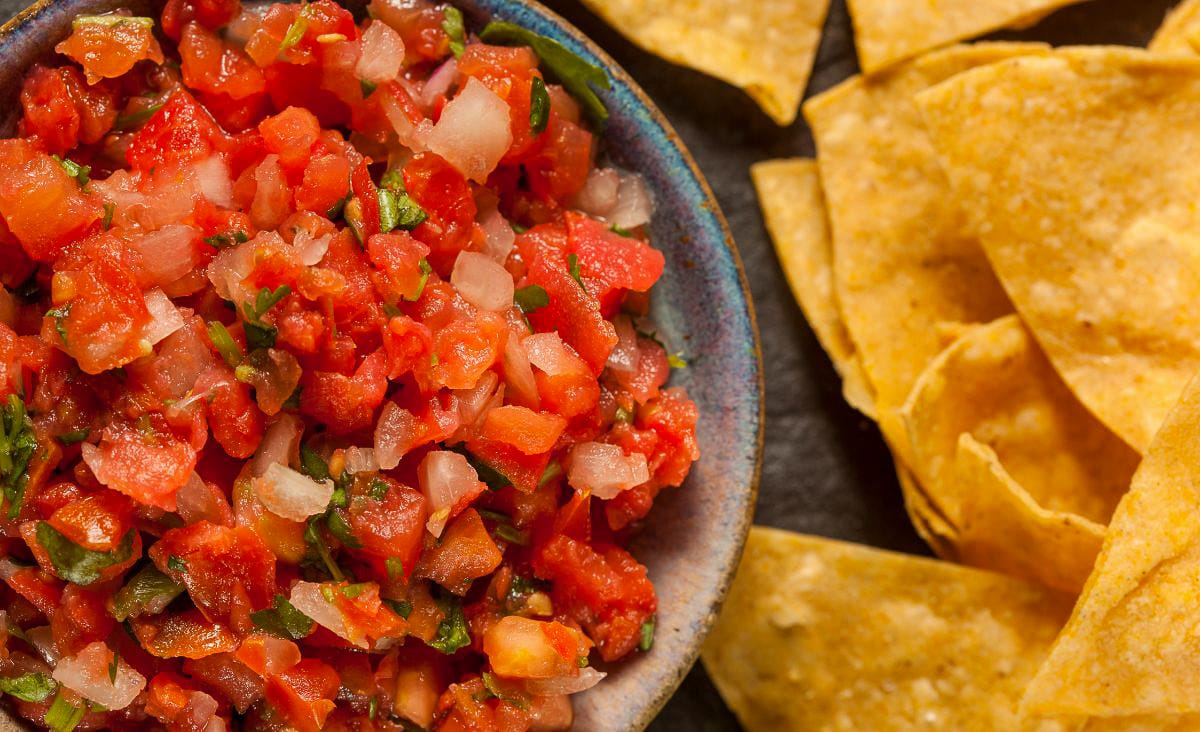
There’s something magical about biting into a fresh summer tomato. Warm from the garden, bursting with flavor, just waiting to be turned into a batch of salsa. Every year, when the tomato plants start going wild, I make sure to set aside a day or two for salsa canning. Because trust me, nothing beats popping open a jar in January and tasting summer again.
This canning salsa recipe from fresh tomatoes has been my go-to for years. It’s simple, full of flavor, and tested for safe water bath canning. If you’re new to canning or just want a reliable recipe that doesn’t require weird ingredients or fancy equipment, this one keeps it simple.
Why This Salsa Recipe Is a Keeper
This isn’t one of those anything-goes salsa recipes. It’s balanced, bold, and has just the right amount of heat. And best of all? It’s safe for canning without pressure.
Here’s why I keep coming back to this one:
- It uses only fresh ingredients (no canned tomatoes or shortcuts).
- The recipe is tested for proper acidity, which is critical for safe water bath canning.
- It’s easy to adjust the heat level without messing up the pH.
- It tastes amazing straight from the jar or after a few months in storage.
Whether you’re stocking your pantry or prepping gifts for the holidays, this is a great place to start.
What You’ll Need
If you’re brand new to canning, I’ve got you covered.
Ingredients (Full recipe in card below)
- Fresh tomatoes (paste varieties like Roma work best)
- Onions
- Jalapeños or other hot peppers
- Bell peppers
- Garlic
- Fresh cilantro (optional)
- Vinegar (5% acidity)
- Canning salt or pickling salt
- Tomato paste (optional for thickening)
Common Paste Tomato Varieties
If you’re looking to go beyond basic Romas, there are plenty of other paste-style tomatoes that work beautifully for canning salsa. These varieties tend to be meatier, less watery, and full of rich tomato flavor. That’s just what you need for a thick, hearty salsa.
Here are some great paste tomato varieties to try:
- Amish Paste – A longtime favorite among home gardeners, Amish Paste tomatoes are large, meaty, and sweet with very few seeds. Great for chunky salsa.
- San Marzano – This Italian heirloom is prized for its rich flavor and low moisture content. It cooks down into a thick, balanced salsa.
- Opalka – These Polish paste tomatoes are long and narrow with dense flesh and a mild sweetness. They’re easy to peel and perfect for smooth salsas.
- Speckled Roman – A fun, striped variety that’s both beautiful and practical. Meaty and low-acid, it adds visual interest to your salsa jars.
- Italian Plum – Similar to Romas, these are reliable paste tomatoes that hold up well to heat and have a classic tomato taste.
- Viva Italia – A hybrid variety known for its productivity and consistency. Great for canning with a balanced, tangy flavor.
If you’re growing your own or buying in bulk at the market, look for tomatoes that feel heavy for their size and have fewer cracks or blemishes. The better your tomatoes, the better your salsa… every time. Not growing your own tomatoes yet? Here’s how to get started with lush, bountiful tomato plants that thrive in your garden.
Equipment
You’ll also need:
- A large pot for cooking the salsa
- A boiling water canner or deep stockpot with a rack
- Canning jars, lids, and rings (I prefer pint jars)
- A jar lifter, funnel, and ladle
Most people blanch tomatoes to peel them, but I’ve got an easier way that doesn’t require boiling water or ice baths. It’s my go-to method during canning season, and it saves so much time. Here’s how I do it.
Step-by-Step: How to Can Salsa from Fresh Tomatoes
Here’s where the real work (and fun) begins. I’ll walk you through it step by step.
Prep the Tomatoes
Start by peeling, coring, and chopping your tomatoes. You’ll need about 10 cups of chopped tomatoes for a medium batch of salsa. This is your base, so choose ripe, flavorful tomatoes (Roma or other paste varieties). If you’re harvesting your own tomatoes for this recipe, make sure you’re picking them at peak ripeness. Here’s how to tell if your tomatoes are ready to pick and preserve.

Chop the Vegetables
Next up… onions, peppers, and garlic. Finely dice everything so the salsa has a smooth texture that’s perfect for chips. The smaller the pieces, the more evenly the flavors blend and it just looks nicer in the jar.
You can mix things up a bit with your veggie choices, but stick to high-acid, canning-approved additions. Bell peppers, hot peppers (like jalapeños or serranos), and sweet onions are all safe bets. You could also toss in a little finely chopped cilantro for flavor and texture.
skip low-acid add-ins like corn, zucchini, carrots, or black beans to this recipe. These ingredients can make your salsa unsafe for water bath canning. If you want to get creative with those, plan to freeze the salsa instead or use a pressure canner.
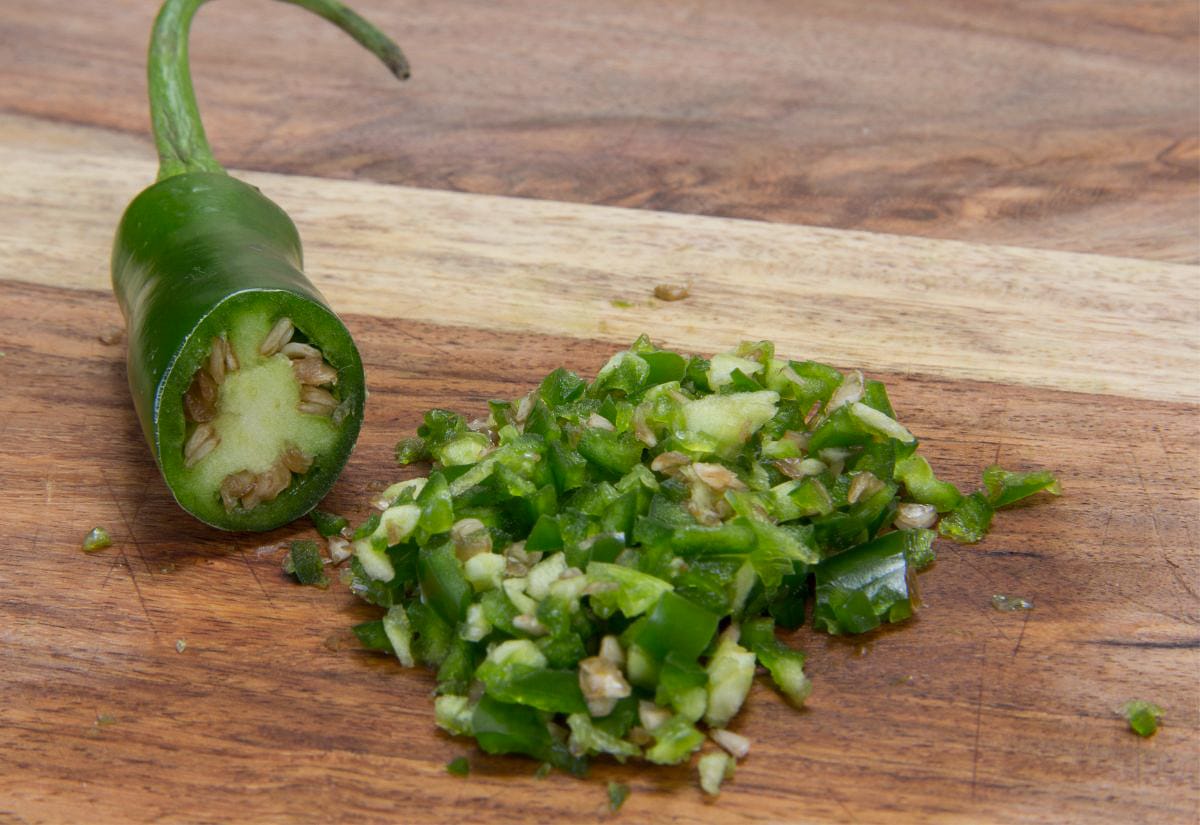
Cook the Salsa
Toss your chopped tomatoes, onions, peppers, garlic, vinegar, and salt into a large, heavy-bottomed pot. Stir it all together and bring the mixture to a gentle boil, then let it simmer for 10–20 minutes. This helps blend the flavors and cook off some of that extra liquid.
Fill the Jars
While the salsa simmers, get your clean, hot jars ready. (You can keep them warm in the canner or your oven at low heat.) Ladle the hot salsa into the jars, leaving ½ inch of headspace at the top.
Use a clean, damp cloth to wipe the rims. Any residue can prevent the lids from sealing properly. Add your lids and screw on the rings until they’re fingertip tight.
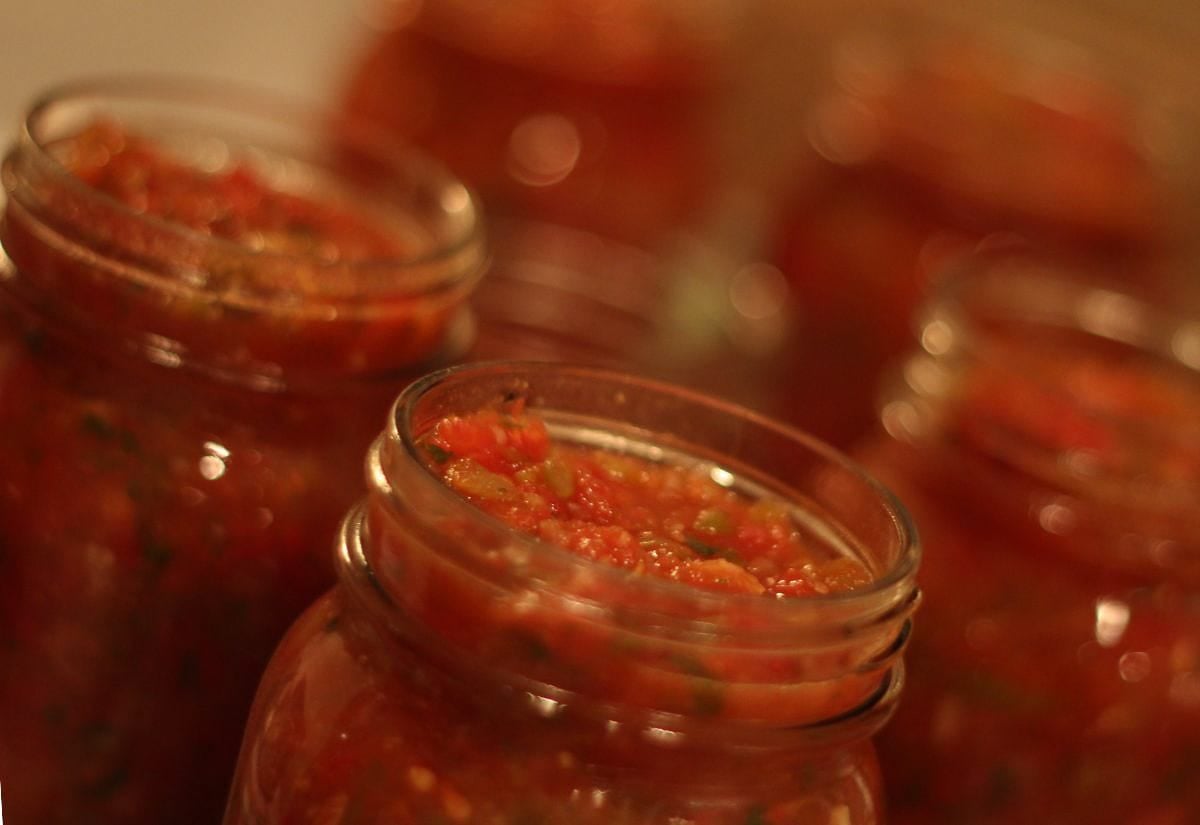
Process the Jars
Place the jars in a boiling water bath canner with at least 1 inch of water covering the tops. Bring the water back to a rolling boil and process the jars for 15 minutes for pint jars. Adjust for altitude if needed (see the note in the recipe card).
Once time is up, turn off the heat and let the jars sit in the canner for 5 minutes before lifting them out.
Cool and Store
Set the jars on a towel-lined counter and leave them alone for 12–24 hours. This gives them time to seal properly.
After they’ve cooled, press the center of each lid. If it doesn’t pop back, you’ve got a good seal. Label the jars with the date and store them in a cool, dark place.
Any jars that didn’t seal? Pop those in the fridge and use them up within a week. (They’re still delicious, just not shelf-stable.)
Canning Safety Notes
Because this is a tomato-based salsa, acidity matters. Don’t cut back on the vinegar, and avoid low-acid add-ins like corn or beans unless you’ve got a tested canning recipe. If you want to modify flavor, do it with herbs and safe swaps like changing the type of pepper.
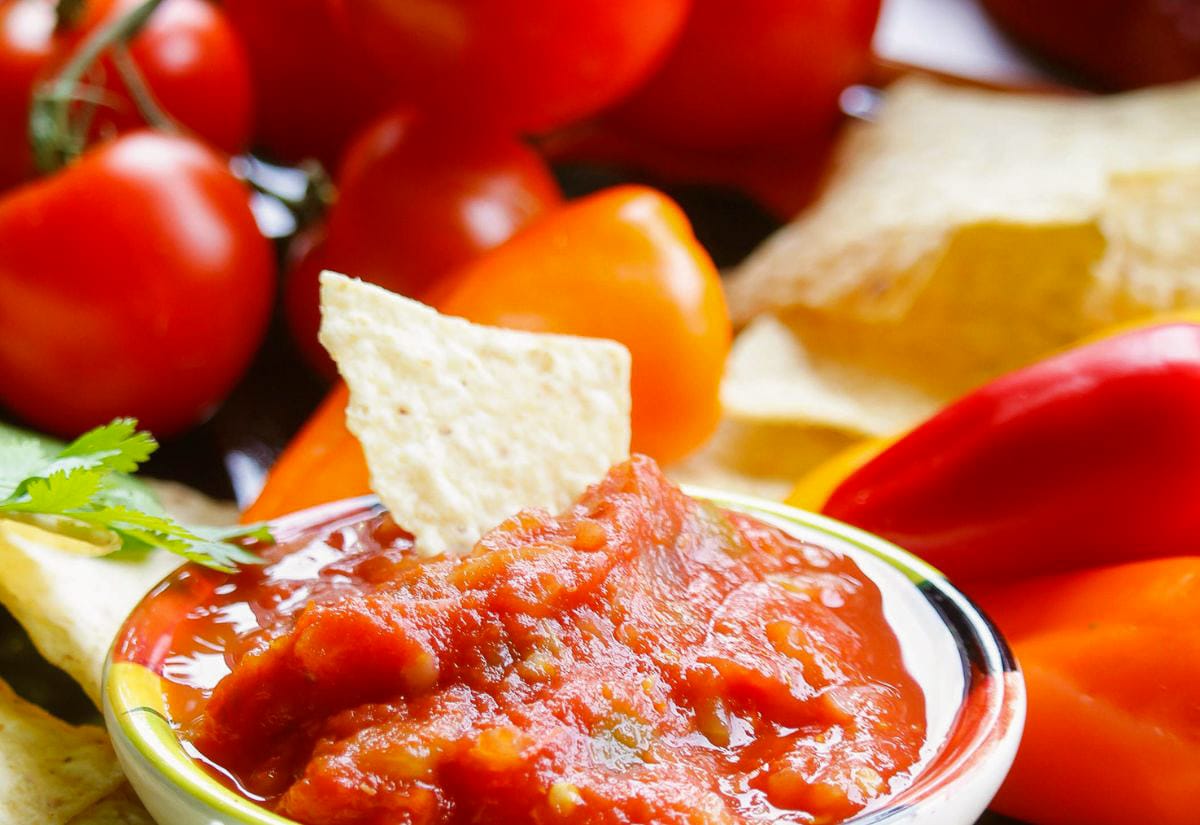
How to Use Your Homemade Salsa
This salsa is more than just a dip. Here’s how we use it:
- Taco nights (obviously)
- Mixed into scrambled eggs or breakfast burritos
- As a base for chili or soups
- Over grilled chicken or fish
- Poured over a block of cream cheese as a party dip
Honestly, the hardest part is not eating it all before winter.
Frequently Asked Questions About Canning Salsa
If you’ve made it this far, you’re probably just about ready to grab your tomatoes and get started. But before you do, here are a few extra questions that often come up after reading a salsa canning recipe, especially if it’s your first time making it from scratch.
Skip store-bought and make your own salsa! This easy, water-bath-safe canning salsa recipe uses fresh tomatoes and garden veggies.
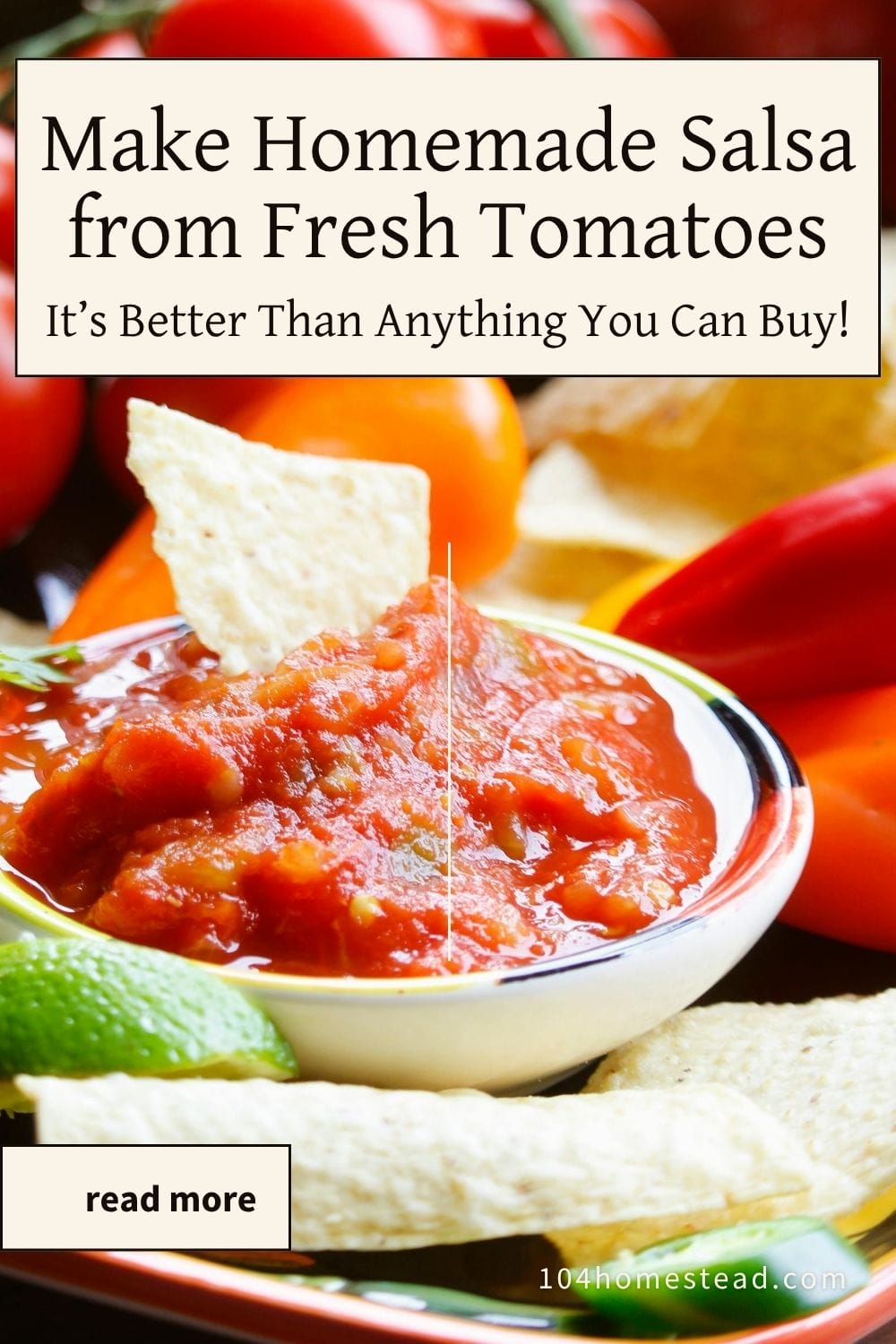
Canning salsa is one of the best ways to make your summer harvest last. It’s satisfying, frugal, and a whole lot of fun once you get the hang of it. This recipe has never let me down and I think it’ll become a favorite in your kitchen, too.
If you make this salsa, let me know how it turned out. I’d love to hear what you’re growing (and preserving) this year.

Garden Fresh Salsa Recipe
This post may contain paid links. If you make a purchase using the links in this recipe, I may earn a commission.
Equipment
- 6 Pint Mason Jars with lids and rings
- 1 Large Stockpot
Ingredients
- 10 cups Fresh Tomatoes
- 5 cups Onions
- 2½ cups Bell Peppers any color
- 1½ cups Hot Peppers like jalapeño; adjust for heat preference
- 6 cloves Garlic
- 1 cup Vinegar white or apple cider; 5% acidity
- 1 tablespoon Canning Salt or pickling salt
- ½ cup Fresh Cilantro (optional)
- Tomato Paste (optional, for thicker salsa)
Instructions
- Blanch, peel, core, and chop tomatoes until you have 10 cups.10 cups Fresh Tomatoes
- Finely dice onions, bell peppers, hot peppers, garlic, and optional cilantro.5 cups Onions, 2½ cups Bell Peppers, 1½ cups Hot Peppers, 6 cloves Garlic, ½ cup Fresh Cilantro
- In a large pot, stir together tomatoes, onions, peppers, garlic, vinegar, salt, cilantro (if using), and optional tomato paste.1 cup Vinegar, Tomato Paste, 1 tablespoon Canning Salt
- Bring to a gentle boil and simmer for 10–20 minutes, stirring occasionally, until slightly thickened.
- Ladle hot salsa into clean, hot pint jars, leaving ½ inch headspace. Wipe rims, add lids and rings, and tighten to fingertip tight.
- Place jars in a boiling water bath canner. Ensure jars are covered with 1–2 inches of water. Bring to a rolling boil and process for 15 minutes (adjust for altitude).
- Remove jars and cool for 12–24 hours. Check seals. Label and store in a cool, dark place. Refrigerate any unsealed jars and use within a week.
Notes
- For best results, use paste-style tomatoes like Roma or San Marzano.
- Wear gloves when handling hot peppers to avoid skin or eye irritation.
- You can safely swap the type of peppers, onions, or herbs, but do not reduce the vinegar or add low-acid ingredients.
- Tomato paste is optional but helps create a thicker, scoopable salsa.
- Altitude adjustments: add 5 minutes for 1,001–3,000 ft, 10 minutes for 3,001–6,000 ft, 15 minutes above 6,000 ft.
